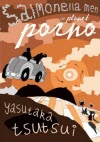Somewhere in Time
Jonathan Clements on the many faces of Japanese science fiction author Yasutaka Tsutsui.
Yasutaka Tsutsui’s most recent book to be published in his native Japan is The Idiot Wall (2010), a polemic about the state of humankind, an angry old writer’s screed about what the world is doing to itself. It is also a challenge to today’s children, daring them to vault the titular barrier and sort out the problems of the world. It is a typically provocative work from an author who has spent the last five decades haranguing the Japanese about life, the universe and everything.
 Despite enjoying superstar status as one of the “Big Three” of Japanese science fiction, Tsutsui remains relatively obscure in the English-speaking world, with only a few novels (Paprika [Purchase], The Maid [Purchase] and Hell [Purchase]) and a handful of short stories. He is substantially better known in France, where he has been decorated as a Chevalier of the Order of Arts and Letters, and several of his more complex works are available in the local language. Many Anglophone fans have only encountered him through the adaptations of his works into anime, such as the dreamscape investigations of Paprika, or the bittersweet classroom comedy of The Girl Who Leapt Through Time.
Despite enjoying superstar status as one of the “Big Three” of Japanese science fiction, Tsutsui remains relatively obscure in the English-speaking world, with only a few novels (Paprika [Purchase], The Maid [Purchase] and Hell [Purchase]) and a handful of short stories. He is substantially better known in France, where he has been decorated as a Chevalier of the Order of Arts and Letters, and several of his more complex works are available in the local language. Many Anglophone fans have only encountered him through the adaptations of his works into anime, such as the dreamscape investigations of Paprika, or the bittersweet classroom comedy of The Girl Who Leapt Through Time.
An author, occasional scriptwriter, TV pundit and sometime actor, Tsutsui graduated from Dōshisha University, Kyoto, in 1957 with a master’s thesis on psychoanalysis and surrealism. He worked for several years at a branch of the Nomura design firm, using his bonus money to produce the fanzine Null (1961-4). Null attracted many young members of the Japanese SF community, folding after its eleventh issue when Tsutsui was drawn into convention activities, professional authorship for SF Magazine, and screenwriting for the anime series Super Jetter. From 1973-7 he was the honorary editor of a new periodical, Neo-Null. Arguably, the influence of both magazines should be attributed not to their initial appearance, but the reprinting of their best stories in several mass-market collections edited by Tsutsui some years later.
Much of Tsutsui’s work for adults contains a cynical attitude towards the mass media; it’s not for nothing that a Guardian review once likened him to “J.G. Ballard, but with a darker past to work out.” His first novel, 4.8 Billion Delusions (1965) featured the agitations of interfering celebrities and journalists who somehow push an insignificant dispute between fishermen into an all-out war. Tsutsui then won the first ever Sei’un Award for long-form fiction with Primates South (1969), a Cold War satire in which a series of misunderstandings and unhappy coincidences lead to the end of the world. The sole remnant of human life is a piece of music set to autoplay on a dead planet. Similarly well received within Japanese fandom was his Samba of Running and Chasing (1972), a darkly self-referential spoof in which the narrator is forced to become an SF author by order of a Kafka-esque job suitability office.
Time Troubles
Although garlanded with serious accolades, Tsutsui is best known in the Japanese mainstream for his young adult book The Girl Who Leapt Through Time. Its original version features a teenage girl who discovers the titular ability — at first only by accident, then through trial and error, and eventual full control. Propelled back only a few days, she tries and largely fails to persuade her classmates of a series of local disasters soon to befall them. She also comes to believe that she is not the only time traveller in the school, eventually discovering that a handsome young boy is actually a visitor from the future.
The Girl Who Leapt Through Time is a summery daydream, a thwarted romance that sees its heroine gain new confidence, find true love, and then lose it all for the preservation of the time continuum. Published in the same year as 4.8 Billion Delusions, it first appeared in two magazines for middle- and high-school students (i.e. for 15-16-year olds), and has since been adapted into several films, TV serials, manga and an award-winning anime. Later iterations either reboot the story, treat the 1960s setting with nostalgia, or refashion the original protagonist as a middle-aged woman, passing on advice to a new heroine. As with James Cameron’s Terminator, it has a story that lends itself well to low budget filmmaking, utilising mundane settings to tell a time-travel story set largely in the present day.
Tsutsui’s original, now 45 years old, remains a staple of the Japanese schooldays experience, kept alive by repeated rebrandings, remakes and reissues. The latest, a live-action film, was released this year. The story was first adapted for the screen as a six-episode children’s TV series, Time Traveller (1972), remade as Girl Across Time in 1994 and again in 2002. But it was the feature film adaptation, Little Girl Who Conquered Time (1983) in cinemas, then in the burgeoning medium of home video, that lingered longest in Japanese memories. The pop idol Tomoyo Harada played the leading role and sung the theme song, and became the most memorable actress to play the lead. When yet another feature remake was commissioned in 1997, Harada returned in a narrator’s role, for a film that retold the story as a 1960s period drama. Suddenly, it seemed, The Girl Who Leapt Through Time had become an old favourite, worn at the edges, only fit to be viewed as a quaint entertainment of yesteryear.
Determined to resist this assumption, Mamoru Hosoda chose to ditch the period setting for his 2006 anime remake. Gone, in this version, is a 1940s subplot, in which a grieving old woman tries to travel in time to retrieve her dying daughter from a WW2 hospital. Gone, too, is the original’s famous protagonist — the character of Kazuko Yoshiyama was now deemed inappropriate for modern audiences. Instead, the anime focuses on a new, tomboy heroine, Makoto, who wastes much of her newly discovered ability to jump through time by using it to relive the balmy, sleepy days of her last month in middle school.
The unwelcome onset of adulthood is a common theme in anime. In the works of Hayao Miyazaki, for example, the ability to see and hear certain creatures fades with age. Voices from the future, from the grown-up filmmakers, draw the audience’s attention to things that children take for granted. The simple delight of riding a bicycle, of seeing a cicada, of living in our own time, are regarded with the elation of a tourist from a future that, it is implied, lacks many modern pleasures. Is this, the filmmakers ask, as good as it gets? Tsutsui’s original also contained a sense of mild, New Wave foreboding, that the future would not as utopian and paradisiacal as we might have hoped. Later adaptations of his most famous story have often played up to this, imparting new hints about forthcoming ecological crises. In the world of Tsutsui’s school days, this really is as good as it gets.
 Almost as influential is his Nanase trilogy of telepath stories beginning with Portraits of Eight Families — the book was first translated under this title by Adam Kabat in 1989 in a Japan-only English-language release. Portraits of Eight Families is a dark comedy of manners, ideally suited to the tensions of Japanese etiquette, featuring a psychic housemaid who is an unwilling witness to the true feelings behind the genteel exchanges between her employers. It has subsequently been re-released in English under variant titles, including What the Maid Saw, and most recently The Maid.
Almost as influential is his Nanase trilogy of telepath stories beginning with Portraits of Eight Families — the book was first translated under this title by Adam Kabat in 1989 in a Japan-only English-language release. Portraits of Eight Families is a dark comedy of manners, ideally suited to the tensions of Japanese etiquette, featuring a psychic housemaid who is an unwilling witness to the true feelings behind the genteel exchanges between her employers. It has subsequently been re-released in English under variant titles, including What the Maid Saw, and most recently The Maid.
Oddly, it was the picaresque sequel Nanase Again (1975) that really caught the Japanese imagination, perhaps because Nanase is on the move, and encounters other people with ESP. In this regard, the story tapped into a fad in the late 1960s and early 1970s for regarding kids of the post-war generation as a “new breed” (shinjinrui). Growing up taller, mouthier and less “Japanese” than their parents, this generation became the subject of sci-fi speculation about the possibility of new mental abilities: in Nanase and others like her, we have the beginnings of the mutants of Akira, and the “newtype” psychics of the Gundam series. The final volume in the Nanase series, Lover of Oedipus (1977) returned Nanase to the workplace in administration at an elite school, where her eavesdropping on others’ true thoughts is sometimes represented in both text and images on alternate pages.
Meta Media
Such textual experiments became a recurring feature in Tsutsui’s works for adults in the 1980s, including an incident in his Virtual Men (1981) in which several pages are left blank when the narrator loses consciousness. Such playful manipulations reflected Tsutsui’s growing interest in metafiction, particularly the “Oulipo” movement, or Ouvroir de littérature potentielle (“works of potential literature”), a club of European writers whose exploits included writing texts that lacked certain letters, limiting themselves to stories that only used certain word-lengths or vowels, and the global swapping out of particular letters or words from their texts. Although still famous in Japan for his books for teenagers, Tsutsui was concurrently redefined as a leading light of post-modern science fiction. Unfortunately, such experiments often rendered his works infuriatingly difficult to translate. His Lipstick on an After-Image (1989) adapted the Oulipo “lipogrammatc” method, dropping specific Japanese symbols from certain chapters. This led to a highly experimental novel in which the words were literally falling off the page. Appreciating the reluctance of readers to engage with such a game of language, his publisher initially offered it for sale with a money-back guarantee. Gaspard in the Morning (1992), the story of an individual immersed in a multiplayer online game, first appeared as a daily serial sponsored by the Asahi Net bulletin board, via which Tsutsui continually solicited reader feedback to steer plot and characterisation.
Tsutsui has courted controversy throughout his career, with a crusade against political correctness that has occasionally led to accusations of misogyny, racism and intolerance. He embarked on a self-imposed authorial strike from 1993-1996, after his story “Unmanned Police” was dropped from a Kadokawa anthology for schools on the grounds of an unacceptable treatment of epilepsy. Tsutsui recounted the incident and its fall-out himself in a series of essays, while another author, Nuiko Satō, wrote an entire book on the scandal.
However, Tsutsui’s departure from books concealed new forays into the digital realm. During his well-publicised absence from print, he was intensely active in digital media, publishing his first “digital book”, a selection of short stories for the Japanese PC-9800 system. He also appeared in a TV commercial for Macintosh computers and was instrumental in the setting up of the e-book server Japan Literature Net.
Lost In Translation?
 Despite increased attention from Anglophone publishers in the early 21st century, Tsutsui’s direct availability in English remains a mere fraction of his domestic output. His short story “Standing Woman” was published in Omni magazine in 1979, and subsequently reprinted in a Japan-only collection intended for students of English, The African Bomb and Other Stories (1986). Both this and the later, larger English anthology Salmonella Men on Planet Porno (2006; trans Andrew Driver) [Purchase] are named after particular Tsutsui collections, but cherry-pick stories from all across his work. Paprika (1993; trans Andrew Driver) garnered a knowing review in the Daily Telegraph, which said: “The nice thing about Tsutsui is that history and modernity combine effortlessly, as do drab reality and fantasy.” Hell (2003; trans Evan Emswiler), in which the newly-deceased are tormented by reliving their worst moments as a time loop, is the most substantial of his works to appear in English, but still a relatively thin book compared to the chunkier items on his bibliography, still awaiting translation.
Despite increased attention from Anglophone publishers in the early 21st century, Tsutsui’s direct availability in English remains a mere fraction of his domestic output. His short story “Standing Woman” was published in Omni magazine in 1979, and subsequently reprinted in a Japan-only collection intended for students of English, The African Bomb and Other Stories (1986). Both this and the later, larger English anthology Salmonella Men on Planet Porno (2006; trans Andrew Driver) [Purchase] are named after particular Tsutsui collections, but cherry-pick stories from all across his work. Paprika (1993; trans Andrew Driver) garnered a knowing review in the Daily Telegraph, which said: “The nice thing about Tsutsui is that history and modernity combine effortlessly, as do drab reality and fantasy.” Hell (2003; trans Evan Emswiler), in which the newly-deceased are tormented by reliving their worst moments as a time loop, is the most substantial of his works to appear in English, but still a relatively thin book compared to the chunkier items on his bibliography, still awaiting translation.
 Tsutsui is well-represented in cross-media adaptations, not only with The Girl Who Leapt Through Time but also with Nanase adapted several times for television and film, two television serials based on his Millionairess Detective and over a dozen more film adaptations of his work. Most of his most famous works have also been adapted into manga. Last year, “The Last Smoker” and “Salmonella Men on Planet Porno” were broadcast as radio plays on BBC Radio Four and Three.
Tsutsui is well-represented in cross-media adaptations, not only with The Girl Who Leapt Through Time but also with Nanase adapted several times for television and film, two television serials based on his Millionairess Detective and over a dozen more film adaptations of his work. Most of his most famous works have also been adapted into manga. Last year, “The Last Smoker” and “Salmonella Men on Planet Porno” were broadcast as radio plays on BBC Radio Four and Three.
Tsutsui has recently celebrated his seventy-sixth birthday. He is one of the grand old men of Japanese science fiction, with a following that spans several generations of Japanese who have grown up reading his bittersweet angle on facing the future. With new films of both Nanase and The Girl Who Leapt Through Time due to reach the English-speaking markets soon, his work continues to speak of things to come.
Some trailers of films based on Tsutsui’s work are available on YouTube:
Nanase Again (2010), live-action film trailer:
The Girl Who Leapt Through Time (2010), live-action film trailer:
The Girl Who Leapt Through Time (2006), anime trailer:
Pingback: The Official Schoolgirl Milky Crisis Blog » Blog Archive » Salon Futura #3
Pingback: Satoshi Kon « hermanovianna
Pingback: It was at 6am - Darlo's World
Pingback: AnimeCloud – Brain Diving
Pingback: Many faces of Yasutaka Tsutsui | Posessed by kujira
Pingback: » Arrivals Spotlight | 10 April 2011 Gav Reads